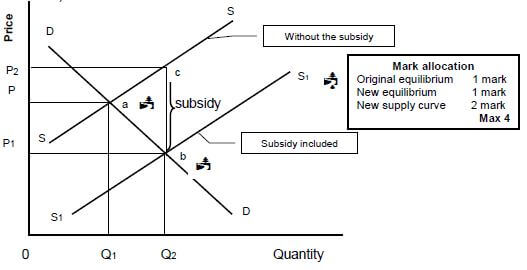ECONOMICS PAPER 2 GRADE 12 MEMORANDUM - NSC EXAMS PAST PAPERS AND MEMOS NOVEMBER 2018
Share via Whatsapp Join our WhatsApp Group Join our Telegram GroupECONOMICS
PAPER 2
GRADE 12
NSC EXAMS
PAST PAPERS AND MEMOS NOVEMBER 2018
MEMORANDUM
SECTION A (COMPULSORY)
QUESTION 1
1.1 MULTIPLE-CHOICE QUESTIONS
1.1.1 C - average ✓✓
1.1.2 B - homogenous ✓✓
1.1.3 A - both variable and fixed ✓✓
1.1.4 C - perfect competitive ✓✓
1.1.5 B - finance ✓✓
1.1.6 D - green ✓✓
1.1.7 D - labour✓✓
1.1.8 A - marketable permits ✓✓ (8 x (16)
2)
1.2 MATCHING ITEMS
1.2.1 E - When it is impossible to increase the welfare of one without decreasing the welfare of another ✓
1.2.2 F - Actual expenditure of a business, e.g. wages and interest ✓
1.2.3 A - Occurs where average revenue is equal to average cost ✓
1.2.4 I - Products that differ, i.e. not similar ✓
1.2.5 B - A sustained decline in the general price level over a period of time ✓
1.2.6 C - Measures that ensure the maximum level of resources used, e.g. tons of fish caught ✓
1.2.7 D - Uncontrolled removal of vegetation in an unsustainable way ✓
1.2.8 G - It is calculated on a basket of goods only ✓ (8 x (8)
1)
1.3 GIVE THE TERM
1.3.1 Fixed ✓
1.3.2 Perfect ✓
1.3.3 Marginal ✓
1.3.4 Stagflation ✓
1.3.5 Cultural/Paleo ✓
1.3.6 Renewable ✓ (6 x 1) (6)
TOTAL SECTION A: 30
SECTION B
Answer TWO of the three questions in this section in the ANSWER BOOK.
QUESTION 2: MICROECONOMICS
2.1 Answer the following questions.
2.1.1 Give any TWO examples of natural monopolies
- Eskom ✓
- De Beers Diamonds ✓
- Water provisioning (to a specific province like Sebideng water / Bloem-water / Umgeni water) ✓
(Accept any other correct relevant response) (2 x 1) (2)
2.1.2 What is the main purpose of markets in the economy?
- Markets bring buyers and sellers together / to determine a price/ regulate the production of goods and services / allocate resources / mechanism to exchange goods and services ✓✓
(Accept any other correct relevant response) (1 x 2) (2)
2.2 DATA RESPONSE
2.2.1 Which institution imposes fines on companies that are guilty of collusion?
- Competition tribunal ✓ (1)
2.2.2 What is the role of the competition appeal court?
- Amend or confirm decisions of the competition tribunal ✓
(Accept any other correct relevant response) (1)
2.2.3 State any ONE aim of the competition policy.
- To prevent monopolies from abusing their power ✓✓
- To regulate the formation of mergers ✓✓
- To stop firms from fixing prices or dividing markets ✓✓
- Promotes fair competition, to enhance economic development to open up opportunities for transformation of the economy ✓✓
- Provide consumers with competitive prices and variety of products ✓✓(2)
2.2.4 How does competition in the market benefit the consumer?
The consumer benefits from:
- larger variety to choose from ✓✓
- lower prices paid for products ✓✓
- better quality of goods and services ✓✓
- equal opportunities to participate in the economy ✓✓
(Accept any other correct relevant response) (1 x 2) (2)
2.2.5 Briefly discuss the success of the competition policy of South Africa.
The competition policy has been successful because:
- many businesses were recently charged and found guilty on the abuse of economic power ✓✓
- in most cases where fines were imposed they were upheld ✓✓
- collusion occurred when Absa and other banks were fixing the exchange rate / through the monopolistic behaviour by Mittal Steel✓✓
- increase in employment through SMME due to their opportunity to enter the market ✓✓
- provision is made for new criminal sanctions to be imposed on individuals ✓✓
- cartel behaviour is prohibited by section 4 (1) (b) of the act. The penalty for participation is a fine up to 10% of the firm’s annual turnover ✓✓
- they prohibited and regulated mergers for example Mass Mart and Wall Mart ✓✓
(Accept any other correct relevant response) (2 x 2) (4)
2.3 DATA RESPONSE
2.3.1 What is the selling price for the business above?
- R150 ✓ (1)
2.3.2 Identify the letter on the graph that represents the loss minimising point.
- c ✓(1)
2.3.3 Briefly describe the term monopoly.
- A market structure where only one seller / producer / manufacturer / supplier operates ✓✓
(Accept any other correct relevant response) (2)
2.3.4 Why is the above equilibrium position typical of the short-run?
- An economic loss is only possible for the monopolist in the short run / monopoly always makes an economic profit in the long-run / labelling of graphs does not indicate long-run ✓✓
(Accept any other correct relevant response) (2)
2.3.5 Determine the loss for this business. Show ALL calculations.
- Loss = Total Revenue - Total Cost
= (150 x 100) - (200 x 100) ✓
= 15 000 ✓ - 20 000 ✓
= - 5 000 ✓
OR
Loss = unit loss (200 - 150) ✓ x quantity (100) ✓
= 50 x 100 ✓
= - 5 000 ✓(2 x 2) (4)
2.4 With the aid of a well-labelled graph (cost and revenue curves) explain shutdown-point for the individual firm in a perfect market.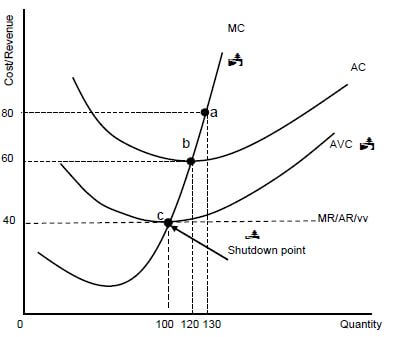
Mark allocation
- Correct positioning of the AVC curve 1 mark
- Correct positioning of MC curve 1 mark
- Correct indication of shutdown point 2 marks
Max 4- it is important that a firm's revenue covers it average variable costs orvariable costs to stay in business ✓✓
- The lowest level of production is 100 where AR = AVC / MC = AVC(shutdown point) ✓✓
- The firm will not produce at prices lower than R40 as AR will be less thanAVC ✓✓
(Accept any other correct relevant response) (Max 6) (8)
2.5 Evaluate the impact of collusion in the economy.
Collusion will impact the economy negatively by:
- reducing competitiveness in the long run by decreasing GDP and employment ✓✓
- allowing price fixing, market sharing and output control by cartels and price leadership ✓✓
- creating scarcity in order to increase prices while also protecting inefficient suppliers ✓✓
- forcing community, consumers, businesses and even governments to pay higher prices for goods and services ✓✓
- distorting economic markets and slowing down innovation because there is little incentive to spend money on research and development ✓✓
Collusion will impact the economy positively by:
- benefiting the supplier by logically fixing prices ✓✓
- benefiting third parties ✓✓ e.g. OPEC (oil cartel) and Greenpeace actually have similar interests - OPEC artificially increase the price of oil through collusion. This reduces quantity consumed. This decreases the 'amount' of negative externalities of pollution ✓
- benefiting the government through increased revenue via indirect taxes on inflationary prices✓✓
(Accept any other correct relevant response) (8)
(Allocate a maximum of 2 marks for the mere listing of facts/examples) [40]
QUESTION 3: CONTEMPORARY ECONOMIC ISSUES
3.1 Answer the following questions.
3.1.1 Give any TWO examples of consumer inflation.
- CPI - headline✓
- Core ✓
- Administered ✓ (2 x 1)
(Accept any other correct relevant response) (2)
3.1.2 What is the main purpose of preservation?
- To prevent the extinction of plant and animal species / to ensure that non-renewable resources are not lost forever ✓✓
(Accept any other correct relevant response) (1 x 2) (2)
3.2 DATA RESPONSE
3.2.1 Identify from the information above the inflation rate that falls outside the inflation target range.
- 6.5% ✓(1)
3.2.2 Give ONE reason for the decrease in the inflation rate.
- Food prices grew at a slower rate ✓
- Lower consumer demand ✓
- Increased agricultural production ✓
- A low brent crude oil price ✓
- Effectiveness of the monetary and fiscal policies / less spending ✓✓
(Accept any other correct relevant response) (1)
3.2.3 Briefly describe the term repo (repurchase) rate.
- It is the rate that commercial banks pay the SARB when borrowing money / Rate at which the Reserve bank lends money to commercial banks ✓✓
(Accept any other correct relevant response). (2)
3.2.4 How will a decrease in the inflation rate benefit the low income earners?
- It will enable low income earners to satisfy more needs ✓✓
(Accept any other correct relevant response) (2)
3.2.5 How can price stability affect the economy positively?
Price stability will influence the economy positively by:
- reducing inflation expectations among consumers, businesses and workers ✓✓
- allowing businesses to make investments in long term projects knowing that prices will be stable ✓✓
- increasing foreign direct investment to benefit economic growth through mass production ✓✓
- allowing consumers to make better decisions that can result in an increase in aggregate demand and economic growth ✓✓
(Accept any other correct relevant response) (2 x 2) (4)
3.3 DATA RESPONSE
3.3.1 Identify the type of pollution in the cartoon above.
- Air pollution / atmospheric pollution ✓ (1)
3.3.2 What major environmental problem can result from the business activities above?
- Climate change / global warming ✓ (1)
(Accept any other correct relevant response)
3.3.3 Briefly describe the term environmental sustainability.
- Environmental sustainability is the ability of the environment to survive its use for economic activity / it refers to meeting the needs of the present generation without compromising the needs of future generations ✓✓
(Accept any other correct relevant response) (2)
3.3.4 What impact will environmental problems have on food security (continuous food production)?
- limiting production due to extreme droughts and floods that might cause heat waves or veld fires ✓✓
- hazardous waste and chemical waste will reduce quality, limit quantities and contaminate food ✓✓
- forcing producers to change their production processes due to a changing climate and cultivate different products which may not be in demand ✓✓
(Accept any other correct relevant response) (2)
3.3.5 How can environmental subsidies be used to ensure sustainable development in South Africa?
- Subsidies can be granted to businesses to reduce environmental damage by recycling of bottles, cans and cardboards ✓✓
- The government can subsidize new technology that saves energy ✓✓ such as energy saving light bulbs or solar geysers,air power to reduce air pollution ✓
- promoting environmentally friendly substitutes like unleaded petrol ✓✓
(Accept any other correct relevant responses) (Max 4) (4)
3.4 Briefly discuss demand-pull inflation and cost-push inflation.
Demand Pull Inflation:
- Demand-pull inflation occurs when aggregate demand in an economy exceeds aggregate supply ✓✓
- Groups responsible for demand inflation are consumers (no savings), businesses (create more credit) and government (less tax is levied) ✓✓
- Foreigners contribute to inflation by increasing the demand for our goods and services through increased exports ✓✓
- A relative increase in aggregate demand components of C, I, G and M ✓✓
- Too much money is chasing too few goods ✓✓
- Increase in wages without an increase in productivity ✓✓ (Max 4)
(Accept any other correct relevant response)
(Allocate a maximum of 2 marks for mere listing of facts/max 1 for example)
Cost Push Inflation
- An increase in labour costs due to aggressive trade union negotiations ✓✓
- Producers increase profits - prices rise more than the rise in production cost ✓✓
- State imposes a higher VAT rate ✓✓
- Expensive imported products (intermediate goods) cause an increase in the prices of locally finished goods ✓✓
- Lower productivity but the same remuneration ✓✓
- Natural disasters i.e. floods or droughts increase the cost of production ✓✓
- Increased total costs on the supply side ✓✓ (Max 4)
(Accept any other correct relevant response)
(Allocate a maximum of 2 marks for mere listing of facts/max 1 for example) (8)
3.5 Why have the international measures (agreements) been ineffective in reducing the effects of climate change?
International measures have been ineffective because:
- there’s a lack of commitment from governments to meet targets set by agreements / monitoring policies ✓✓
- emission targets are not met, and the effects of climate change is more visible than ever before, leading to a loss in GDP and a decrease in employment ✓✓
- it is difficult to identify organizations responsible for holding these countries accountable for their actions ✓✓
- there is a lack of strict law enforcement where penalties were not imposed on those who did not meet targets ✓✓
- conflicting interests existed between the goal of achieving sustainable development and that of increased economic development ✓✓
- big polluters (like the US) failed to meet the targets set by Kyoto protocol and still contribute to global warming and are less interested in solving the crisis due to expensive technology to reduce pollution ✓✓
(Accept any other correct relevant answers) (8)
(Allocate a maximum of 2 marks for mere listing of facts/examples) [40]
QUESTION 4: MICROECONOMICS AND CONTEMPORARY ECONOMIC ISSUES
4.1 Answer the following questions.
4.1.1 Give any TWO examples of hazardous waste affecting the environment.
- Pesticides ✓
- Toxic metal waste (lead, mercury, oil spills) ✓
- Radio-active waste (using nuclear fuel rods) ✓
(Accept any other correct relevant response) (2 x 1) (2)
4.1.2 Why are merit goods normally undersupplied by the market?
- The market only produces goods that are profitable / Some goods are highly desirable for the general welfare of the people but not highly rated by the market / private cost exceeds private benefit / if they had to be paid for, relatively little would be consumed ✓✓
(Accept any other correct relevant response) (1 x 2) (2)
4.2 DATA RESPONSE
4.2.1 Give ONE example of a monopolistic competitor that only specialises in chicken.
- KFC ✓
- Chicken Licken✓
- Nando's ✓
- Hungry lion ✓
(Accept any other correct relevant response) (1)
4.2.2 Identify the concept that describes a combination of perfect competition and a monopoly.
- '… hybrid …' / monopolistic competition ✓ (1)
4.2.3 Why does branding play a major role in monopolistic competition?
- Branding differentiate between products from competitors and builds customer loyalty ✓✓
(Accept any other correct relevant response) (2)
4.2.4 Give a reason why businesses in the monopolistic competitive market prefer to compete on a non-price basis.
- Non-price competition allows them to focus on the uniqueness of the product which can increase sales ✓✓
- They do not compete based on price because it causes price wars and can drive prices down due to many sellers ✓✓
(Accept any other correct relevant response) (2)
4.2.5 Why will the economic profit made by a monopolistic competitor disappear in the long-run?
Economic profit will disappear in the long run because:
- profits attract new businesses easily into the market making it more competitive ✓✓
- increased competition will lead to a decrease in prices which will reduce profits ✓✓
- there can be an increase in the number of substitute products produced which will reduce the demand✓✓
- this will eventually lead to normal profit by the monopolistic competitor in the long-run ✓✓
(Accept any other correct relevant response) (2 x 2) (4)
4.3 DATA RESPONSE
4.3.1 What is the main reason behind the poaching of Rhinos?
- Rhino horn/Money ✓
(Accept any other correct relevant response) (1)
4.3.2 During which year did South Africa experience its worst year in Rhino poaching?
- 2014 ✓ (1)
4.3.3 Briefly describe the term biodiversity.
- Biodiversity refers to the variety of plants and animals that inhabit the earth ✓✓
(Accept any other correct relevant response) (2)
4.3.4 Give ONE example how an awareness of the natural fauna and flora can be created.
- Making children and adults more aware of environmental issues through the media and school visits ✓✓
- Setting up community wildlife reserves as national parks ✓✓
- Field trips, guided environmental tours ✓✓
- Use the media like facebook or the radio to create an awareness ✓✓
(Accept any other correct relevant response) (2)
4.3.5 How will conservation benefit the people living near the Rhino habitat?
Local people will benefit from all the spin-offs from the development of wildlife reserves by:
- using a variety of infrastructure like roads, water, transport and shopping facilities ✓✓
- enjoying more job opportunities that will lead to an increase in the standard of living ✓✓
- improving entrepreneurial abilities through manufacturing of handcrafts ✓✓
- enjoying social benefits like clinics and community activities ✓✓
(Accept any other correct relevant response) (2 x 2) (4)
4.4 With the aid of graphs, briefly explain how price is determined for an individual producer in a perfect market.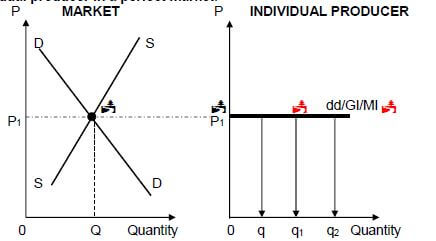
Mark allocation:
Interaction of supply and demand = 1 mark
Link between market price and the price of the individual firm = 1 mark
Correct drawing of demand curve of individual producer = 1 mark
Correct labelling of demand curve of individual producer = 1 mark
Max. 4 marks
- The market forces of demand and supply determines the price (OP1) ✓✓
- The sellers are too insignificant to influence the market price, hence they are price takers ✓✓
- Each individual producer is forced to sell his goods at market price. Thus the demand curve is flat/horizontal/perfectly elastic (curve dd) ✓✓
- The individual producer will not increase his price because he would not be able to sell any products, nor lower his price because he will be able to sell all his products at market price ✓✓
(Accept any other correct relevant response) (Max 6) (8)
4.5 How can South African households contribute to a lower inflation rate?
South African households can contribute to a lower inflation rate by:
- saving a bigger portion of their income makes money available to contribute towards capital formation by businesses ✓✓
- limiting luxurious spending on goods and services to their disposable income ✓✓
- demanding wages which are in line with the current inflation rate ✓✓
- increasing their productivity to ensure that the money they receive for their labour matches the income they receive ✓✓
- reducing the demand for loans and other forms of credit ✓✓
- reduce industrial actions that may reduce production of goods and services ✓✓
(Accept other correct relevant response)
(Allocate a maximum of 2 marks for the mere listing of facts/examples) (8) [40]
TOTAL SECTION B: 80
SECTION C
Answer any ONE of the two questions in this section in the ANSWER BOOK.
QUESTION 5: MICROECONOMICS
- Discuss the consequences of market failure with the aid of graphs under the following headings:
- Producer Subsidies (8)
- Maximum prices (8)
- Minimum wages (10) (26 marks)
- With reference to the graph below, analyse how a negative externality result in the misallocation of resources. [40]
INTRODUCTION
Market failure is when the market fails to produce sufficient (optimum) quantities that people want. ✓✓
(Accept any other relevant introduction) Max (2)
MAIN PART
Producer Subsidies
- A subsidy is a form of financial grant to support the production of a good or service by the government by lowering the cost of production ✓✓
- Subsidies can be direct (e.g. cash grants) or indirection (e.g. depreciation ite-off) ✓✓

- The market price decrease from P to P2, and the quantity consumed will increase from Q to Q1 due to the subsidy paid by government ✓✓
- The producer benefits from a subsidy/producer's profit increases (the difference between P and P2) ✓✓
- The consumer benefits from a subsidy by paying less (price decreased from P to P1) ✓✓
- Producer subsidies are often given to suppliers of agricultural products such as milk, wheat and maize ✓✓ (Max. 6)
Maximum Prices
- Sometimes the government will set the price of a good or service at a maximum price that is below the market price/The government intervenes and passes a law that suppliers may not charge more than the maximum price ✓✓
- Maximum price are usually set on basic goods, such as food and transport so that citizens have access to certain goods and services and achieve a certain minimum standard of living ✓✓
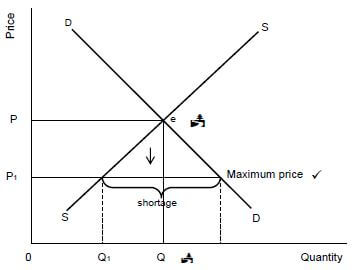
Mark allocation
Original equilibrium 1 mark
Indication of quantity change 1 mark
Indication of maximum price 2 mark
Max 4 marks
- In the figure above, the maximum price is set at P1, while the market price is at P ✓✓
- The immediate effect would be that the quantity supplied will drop from Q to Q1 ✓✓
- The shortage caused by the price ceiling creates a problem of how to allocate the good since the demand will exceed the supply ✓✓
- Black markets often develop where illegal goods are bought or sold ✓✓ (Max 6)
Minimum Wages
- When the government enforces a minimum wage, it means workers have to be paid a certain minimum remuneration that will lead to a higher standard of living / increased satisfaction of wants ✓✓
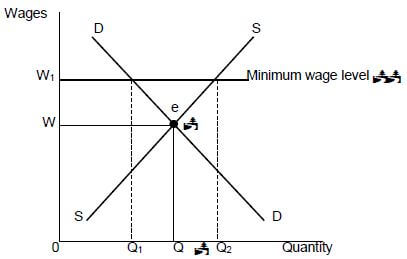
Mark allocation
Original equilibrium point = 1 mark
Indication of quantity change = 1 mark
Indication of min wage = 2 marks
Max 4 marks
- The graph shows that if the wage rate is set at W, the corresponding demand and supply of labour will be Q ✓✓
- If a minimum wage of W1 is set, the demand for labour will decrease from Q to Q1. Some people may become unemployed ✓✓
- However, the supply of labour will increase from Q to Q2. As more people will offer their labour because of a higher income ✓✓
- Minimum wages will lead to more bargaining power of workers ✓✓ (Max 8)
(Accept any other correct relevant response)
(Allocate a maximum of 8 marks for the mere listing of facts/examples) (Max. 26)
ADDITIONAL PART
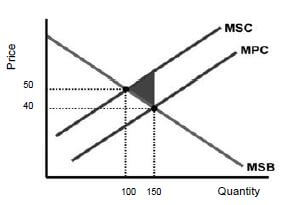
A negative externality results in the misallocation of resources :
- Because external costs are not included in the price when the market produces 150 units ✓✓
- If external costs are included the supply will decrease and market will produce at 100 units at a higher price of R50, that is socially desirable ✓✓
- Since the market does not take external cost into account it over-produces thus more resources than it socially desirable is used ✓✓
- harming other producers or consumers through the behaviour of certain producers that impact negatively on the cost structure of other participants✓✓
- charging a price of R40 for quantity 150 sold, that represents only private cost (MPC)✓✓
- reaching the socially optimal point of production if social cost is taken into account, that will lead to a price increase to 50 and the quantity reducing to 100✓✓
- producing too much of a good which has a negative externality (welfare loss) indicated by the shaded area on the graph ✓✓
- at R40 if the market is left to its own devices, a quantity of 150 will be produced (socially insufficient) ✓✓ (Max 10)
CONCLUSION
Government involves itself directly in the market when the market does not act in the interest of society ✓✓
(Accept any other correct relevant higher order response) Max (2)
QUESTION 6: CONTEMPORARY ECONOMIC ISSUES
- Discuss the effects of tourism. (26 marks)
- Evaluate the success of indigenous knowledge systems (IKS) in promoting tourism in South Africa. (10 marks) [40]
INTRODUCTION
Tourism is the activities of people travelling to and staying in places outside their usual environment for no more than one consecutive year for leisure, business and other purposes. ✓✓
(Accept any other correct relevant introduction) (Max. 2)
BODY: MAIN PART
GDP ✓
- Tourism is the fourth-largest industry in South Africa and supports about 700 hotels, 2 800 guesthouses and bed-and-breakfast establishments and 10 000 restaurants ✓✓
- Tourism has the potential of bringing the economy out of a slump, although it dropped by 5% before 2010, it increased by 5% thereafter ✓✓
- Tourism has direct as well as indirect impacts on the GDP.
Direct impact Indirect impact Tourism contributed 3% of the GDP in 2018 Tourism contributed 9% in 2018 Internal spending on travel and tourism by residents and non-residents for business and leisure Government and private sector spending such as purchase of new aircrafts and construction of new hotels
Employment ✓
Tourism:
- industry employs about 7% of the South African workforce, and is potentially regarded as the largest provider of jobs and earner of foreign exchange ✓✓
- industry has employed more than 1,2 million people ✓✓
- is ideal for providing employment in areas that offer few employment opportunities ✓✓
- is labour intensive although it has the lowest ratio of investment to employment creation ✓✓
- uses different skills, from accountants to hairdressers ✓✓
- has the potential to create jobs and offer opportunities for small entrepreneurs ✓✓
- provides immediate employment like live entertainment at holiday resorts ✓✓
- provides entrepreneurial opportunities in the informal sector such as fruit vendors ✓✓
Poverty ✓
- The income the tourism industry earns contributes to the country's growth and development. Tourism can affect the lives of the poor in many ways ✓✓
- The Department of Tourism is involved in poverty relief projects that promote community owned tourism products and services ✓✓
- Poverty relief programme manages and administer poverty relief proposals and spin-off projects in the tourism and environment sectors ✓✓
- Their focus is on infrastructure investment (e.g. information centres, tourist ablution facilities, walkways) and product development (e.g. heritage sites, rock art and conservation) ✓✓
- Through this programme, the DEAT is seeking to provide long-term sustainable work opportunities for the members of South Africa's poorest communities in rural areas ✓✓
- Tourism is an effective mechanism for distributing resources to rural areas to develop them as tourist sites✓✓
Tourism externalities ✓
- Tourism activities may result in benefits or costs to third parties who are not part of the buyer-seller market ✓✓
- Negative externalities: Aircraft noise disturbing residents near airports ✓✓
- Other examples/costs: Traffic and congestion, extra policing due to crime, increased health service and sanitation, destruction of flora and fauna, spoiling views of the landscape, increased maintenance of infrastructure ✓
- Positive Externalities: the Gautrain provides links to different areas speedily especially to the airport ✓✓
- Other benefits are new recreational amenities, increased direct and indirect tax revenue ✓✓
- Tourism can cause inflation, which makes some goods unaffordable to locals ✓✓
The environment ✓
- The influx of tourism and vehicles into conservation areas damages grass cover affecting plant and animal species. ✓✓
- Tourism involves transport and transport is a major 'source of pollution' ✓✓
- Policy should be in place to ensure tourists are transported in the most environmentally friendly way ✓✓ e.g. Rickshaw at the beachfront, horse-riding, cycling ✓
- The use of the Gautrain is more environmentally friendly as it decreases carbon emissions ✓✓
- The rapid degradation of the environment poses a major threat to the tourism industry ✓✓
- The environment is divided in four main categories: permanent environmental restructuring like airports ✓✓ direct environmental stress caused by tourist activities ✓✓
- effects on population dynamics ✓✓
Investment/ infrastructure ✓
- Tourism leads to increased demand, which makes business more willing to invest in capital goods and labour✓✓
- Government expenditure on infrastructure is encouraged because it can generate income ✓✓
- With regard to travel and tourism, infrastructure includes fixed passenger transportation investment, destination services such as power, water and sewerage, cleaning and health, fixed communications investments ✓✓
- South Africa has a first-world infrastructure; however, there is a lack of infrastructure in the rural areas, which limits the participation of the rural communities in the tourism industry ✓✓
- The absence of adequate transportation services also prevents rural communities from participating in the tourism industry, both as potential suppliers of products, and as tourists themselves ✓✓
- Energy infrastructure like electricity needed by tourists at tourist sites ✓✓
- Tourists need basic services like clean water and refuse removal ✓✓
(Accept any other relevant response)
(Allocate a maximum of 8 marks for the mere listing of facts/examples) (Max 26)
ADDITIONAL PART
Evaluate the success of indigenous knowledge systems (IKS) in promoting tourism in South Africa.
Indigenous Knowledge Systems (IKS) is successful in promoting tourism in South Africa by:
- offering unique attractions it encouraged foreign tourists to learn about South Africa's indigenous culture, history and cultural diversity ✓✓
- giving tourists an opportunity to experience the indigenous culture ✓✓ e.g. cultural villages such as Shangana in Mpumalanga and Basotho in Free State ✓
- offering inexpensive cultural tours based on indigenous knowledge ✓✓
- encouraging government to create policies to protect, develop and promote indigenous knowledge systems ✓✓ e.g. medicine, arts and crafts ✓
- expanding the experiences of tourists in township by visiting places ✓✓such as Soweto where they can eat and drink at a shebeen ✓
- displaying African art and culture ✓✓ e.g. music the National Arts festival held in Grahams town caters for this need ✓
- developing sites of cultural and historical importance ✓✓ such as Robben Island ✓
(Accept other correct relevant response) (Max. 10)
CONCLUSION
Marketing of tourism products to both domestic and international markets is important for achieving the full growth potential of the sector in South Africa ✓✓ [40]
(Accept any other correct relevant higher order response) (Max. 2)
TOTAL SECTION C: 40
GRAND TOTAL: 150
